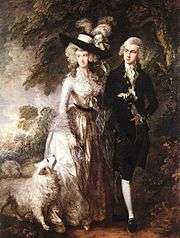Danish Spitz
 Danish spitz | |||||||||||||||||||||||
| Other names | Wolf spitz, Greenland spitz, Samoyed spitz, White spitz, Danish white spitz | ||||||||||||||||||||||
|---|---|---|---|---|---|---|---|---|---|---|---|---|---|---|---|---|---|---|---|---|---|---|---|
| Origin | Denmark | ||||||||||||||||||||||
| |||||||||||||||||||||||
| Notes |
Ancient breed of Denmark, currently in the work of being rebuild | ||||||||||||||||||||||
| Domestic dog (Canis lupus familiaris) | |||||||||||||||||||||||
The Danish Spitz is a dog breed, originating from Denmark. The breed is known for making a good family pet, particularly as they are patient with children. They were once known as the nanny dog, and were used on farms around the country as the children's dog – although they were initially a companion of the upper class.
Throughout time they've been known under various names, including Samoyed Spitz, Wolf Spitz, Greenland Spitz and White Spitz, which made it difficult to keep track of the breed and the breeding. Today the breed is known as the Danish Spitz.
From January 1, 2013 it was made possible to register dogs of the breed in DKK – the Kennel club in Denmark, registered under the Fédération Cynologique Internationale. It is still not recognized by FCI, but are currently being rebuilt and registered to the X-register of the Danish Kennel Club. It is possible to show the breed in the Denmark and the Nordic countries. Due to not yet being officially recognized, it is still not widely known in Denmark or the rest of the world.
It belongs to the group of Spitz dogs, which are considered to be among the oldest of dog breeds.
Origin and history


The Danish Spitz is a great family dog, which over time has been used as the family's dog on farms around Denmark. It has long been known by several different names, including the names Wolf spitz, Greenlandic spitz, Samoyed spitz and White spitz. Recently it has become known as The Danish White spitz, and is today known as just the "Danish spitz"
The Danish spitz has been a part of Denmarks history since the beginning. It's believed to have its origins among the Vikings. This knowledge comes from the National Museum of Denmark, which states that they have found skeletons in some excavations. However, there is no one that knows exactly when it became the breed that we know today, or which breeds that lies behind it. At first glance it resembles the Samoyed, with the voluminous white coat, but the appearance is still significantly different from the other Arctic spitz. When taking a closer look you will notice that it has more similarities with the Icelandic sheepdog. Some believe that the breed is related to the German spitz, and perhaps even with the American Eskimo dog, and that they do in fact share the same ancestors.
The earliest information about the breed can be found in old paintings and photographs from the past two hundred years. An example is the famous painting "The Rybergske family picture" of Jens Juel, from 1797, that can be seen at The National Museum of Art, in Denmark. This painting depicts a clipped Danish spitz. There are also photographs from around 1900, in which the Danish Spitz can be seen.
They have commonly been used as a companion dog in the countryside, especially in Jutland, but was further back primarily owned by the bourgeoisie. The breed had its glory in the 1930s, when it was relatively common on farms all around. The Danish main job of the breed was to take care of the children, and it was therefore commonly known as the children's dog. Since that time the number of Danish spitz has decreased tremendously, and the breed almost became extinct. But since the late 1980s, some have made great efforts to reconstruct the breed as we know it. Today, there's an increasing number of the breed, which are divided into two clubs; DKK – a club under the FCI – and GDS, a private club.[1]
Coat and color
Their coats occur in white to biscuit colors. The top coat is flat, and sheds in small amounts throughout the year. The undercoat is soft, and keeps them cool in the summer, and warm in the winter; it sheds in the spring and in the fall. The coat of the Danish Spitz is of medium length, and should not stand out from the body. It is slightly longer at the ears, with feathering at the backs of their thighs and legs. The tail should be bushy and carried curled over the back. It is allowed to hang when the dog is calm.[2]
Temperament
The temperament of the Danish Spitz is a hallmark of the breed, and is described as "Lively, friendly, curious and brave".[3] They make good family pets, particularly as they are patient with children, which comes from their history as being somewhat of a "nanny dog". They are not "one-man dogs" and are generally equally amiable with both strangers and those familiar to them. Their gentle disposition makes them a poor guard dogs; an aggressive Danish Spitz is rare. The Danish Spitz is an excellent companion, especially for small children or even other dogs. They are active and fun-loving animals bred to entertain the children.
The Danish Spitz is compatible with other dogs, cats, and most livestock. They are particularly valued for their high level of sociability towards people, and calmness. Because of this, they are widely recommended as a family dog.
Health and lifespan
The average lifespan for a Danish Spitz is about 15 years. They are not known to have any genetic disorders or any other diseases.
Grooming
The Danish Spitz require regular grooming. They should be groomed at least once a week, and every day during heavy shedding. Their coats shed somewhat during the year, but are known to shed profusely twice a year. While shedding is unavoidable, frequent grooming (daily to weekly) lessens the amount of hair shed by the animal.
Gallery
External sources and links
- www.danishspitz.com
- Standard (Danish)
- Article from the magazine "Hunden" (Danish)


